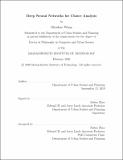Deep neural networks for choice analysis
Author(s)
Wang, Shenhao.
Download1237278820-MIT.pdf (5.481Mb)
Other Contributors
Massachusetts Institute of Technology. Department of Urban Studies and Planning.
Advisor
Jinhua Zhao.
Terms of use
Metadata
Show full item recordAbstract
As deep neural networks (DNNs) outperform classical discrete choice models (DCMs) in many empirical studies, one pressing question is how to reconcile them in the context of choice analysis. So far researchers mainly compare their prediction accuracy, treating them as completely different modeling methods. However, DNNs and classical choice models are closely related and even complementary. This dissertation seeks to lay out a new foundation of using DNNs for choice analysis. It consists of three essays, which respectively tackle the issues of economic interpretation, architectural design, and robustness of DNNs by using classical utility theories. Essay 1 demonstrates that DNNs can provide economic information as complete as the classical DCMs. The economic information includes choice predictions, choice probabilities, market shares, substitution patterns of alternatives, social welfare, probability derivatives, elasticities, marginal rates of substitution (MRS), and heterogeneous values of time (VOT). Unlike DCMs, DNNs can automatically learn the utility function and reveal behavioral patterns that are not prespecified by modelers. However, the economic information from DNNs can be unreliable because the automatic learning capacity is associated with three challenges: high sensitivity to hyperparameters, model non-identification, and local irregularity. To demonstrate the strength of DNNs as well as the three issues, I conduct an empirical experiment by applying the DNNs to a stated preference survey and discuss successively the full list of economic information extracted from the DNNs. Essay 2 designs a particular DNN architecture with alternative-specific utility functions (ASU-DNN) by using prior behavioral knowledge. Theoretically, ASU-DNN reduces the estimation error of fully connected DNN (F-DNN) because of its lighter architecture and sparser connectivity, although the constraint of alternative-specific utility could cause ASU-DNN to exhibit a larger approximation error. Both ASU-DNN and F-DNN can be treated as special cases of DNN architecture design guided by utility connectivity graph (UCG). Empirically, ASU-DNN has 2-3% higher prediction accuracy than F-DNN. The alternative-specific connectivity constraint, as a domain-knowledge- based regularization method, is more effective than other regularization methods. This essay demonstrates that prior behavioral knowledge can be used to guide the architecture design of DNN, to function as an effective domain-knowledge-based regularization method, and to improve both the interpretability and predictive power of DNNs in choice analysis. Essay 3 designs a theory-based residual neural network (TB-ResNet) with a two-stage training procedure, which synthesizes decision-making theories and DNNs in a linear manner. Three instances of TB-ResNets based on choice modeling (CM-ResNets), prospect theory (PT-ResNets), and hyperbolic discounting (HD-ResNets) are designed. Empirically, compared to the decision-making theories, the three instances of TB-ResNets predict significantly better in the out-of-sample test and become more interpretable owing to the rich utility function augmented by DNNs. Compared to the DNNs, the TB-ResNets predict better because the decision-making theories aid in localizing and regularizing the DNN models. TB-ResNets also become more robust than DNNs because the decision-making theories stablize the local utility function and the input gradients. This essay demonstrates that it is both feasible and desirable to combine the handcrafted utility theory and automatic utility specification, with joint improvement in prediction, interpretation, and robustness.
Description
Thesis: Ph. D. in Computer and Urban Science, Massachusetts Institute of Technology, Department of Urban Studies and Planning, September, 2020 Cataloged from student-submitted PDF of thesis. Includes bibliographical references (pages 117-128).
Date issued
2020Department
Massachusetts Institute of Technology. Department of Urban Studies and PlanningPublisher
Massachusetts Institute of Technology
Keywords
Urban Studies and Planning.